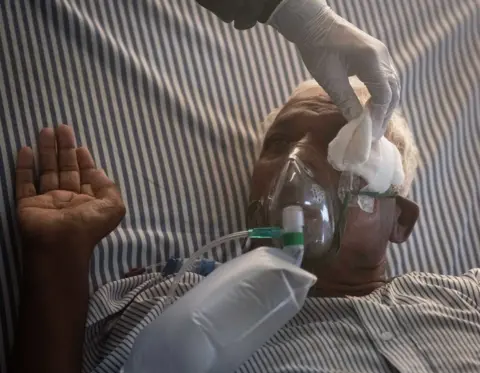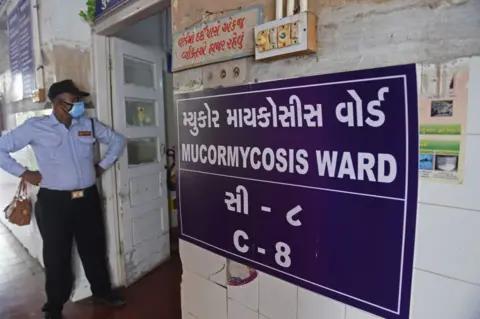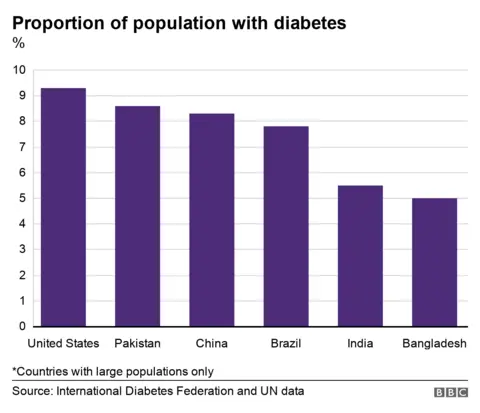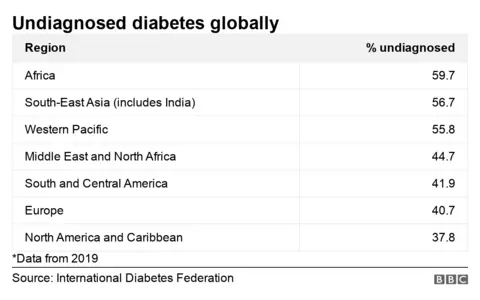Black fungus: Is diabetes behind India's high number of cases?
 Getty Images
Getty ImagesAbout 12,000 cases of a condition known as "black fungus" have been reported in India, mostly in patients recovering from Covid-19.
This severe infection is normally very rare and has a mortality rate of about 50%.
Some medical experts have suggested India has seen cases growing because of the high prevalence of diabetes.
But are other factors at work and what is happening in other countries?
Which countries have got black fungus?
Prior to the Covid pandemic, at least 38 countries around the world had reported cases of mucormycosis, more commonly known as black fungus.
India and Pakistan had the highest rates with around 140 cases per million annually, according to Leading International Fungal Education.
 Getty Images
Getty ImagesDr David Denning at the University of Manchester, an expert on fungal infections, says reported cases of black fungus in India were "masses more than any other part of the world" well before the pandemic.
"Mucormycosis is strongly linked with poorly controlled diabetes and there's a lot of it [diabetes] in India."
In patients recovering from Covid-19, according to a recent research paper looking at cases globally, 94% of those who had the fungal infection also suffered from diabetes.
And the majority (71%) of the reported cases of black fungus were from India.
Is a link to diabetes seen in other countries?
Of the top countries with a high per-capita prevalence of diabetes, others (apart from India) have reported cases of mucormycosis.

India's neighbours, Pakistan and Bangladesh, both have a high prevalence of diabetes in their populations, and have had mucormycosis cases - but not in especially large numbers.
In Bangladesh, doctors have been treating one confirmed case of mucormycosis and are awaiting test results for another suspected case.
Doctors told the BBC that both patients also had diabetes.
Pakistan has also reported five cases of mucormycosis in recent weeks and four had died as of 12 May, according to media reports.
Brazil has reported 29 cases so far, but it's not yet clear how many of these had Covid and/or were diabetic.
Russia has also reported "isolated" cases of mucormycosis in Covid patients recently - but it is unclear how many have been detected so far.
The US has a very high prevalence of diabetes - 9.3% of the population is estimated to have the condition.
It also has the highest number of Covid cases globally.
But mucormycosis is very rare - diabetes cases there are largely managed with only 3% going undiagnosed, according to the US Centers for Disease Control.
Why might diabetes be a risk factor?
Experts say it's not so much recorded cases of diabetes as the levels of undiagnosed diabetes that are the issue.

The IDF estimates that about 57% of those with diabetes in India, Nepal, Bangladesh, Sri Lanka are undiagnosed cases - and nearly all of these are found in India.
Pakistan is also estimated to have a high proportion of undiagnosed diabetes.
"There's a lot of uncontrolled diabetes in India because people don't do regular health check-ups," says Dr Hariprasath Prakash at the International School of Medicine in Kyrgyzstan.
He says a large majority of diabetes cases are "discovered through other health complications" and remain untreated.
Poorly controlled diabetes puts you at higher risk of certain infections, including some fungal ones.
The Africa region also has a high proportion of undiagnosed diabetes at nearly 60%, but estimates show the incidence of mucormycosis there is low - only 3%.
Dr Denning points out that "it could be because [mucormycosis] cases might be going undiagnosed... it is not the easiest thing to diagnose."
Studies have suggested that cases of black fungus go undiagnosed because of the difficulty in tissue sample collection and the lack of sensitivity of the diagnostic tests.
What else might cause black fungus?
Experts also suggest that the indiscriminate use of steroids for some Covid treatments could be linked to mucormycosis or other fungal infections.
Two widely prescribed steroids - dexamethasone and methylprednisolone - are used for Covid patients in India to reduce the inflammation caused by the body's immune response.
 Getty Images
Getty ImagesHowever, with hospitals and doctors overwhelmed by a growing numbers of cases, there's evidence that these steroids are being taken without medical supervision.
The Indian authorities have recently warned against such self-medication, which can have seriously harmful consequences including, says Dr Denning, such as an increased the risk of developing mucormycosis.
A UK-based trial conducted on around 2,000 Covid patients showed that dexamethasone helped reduce mortality in those with a moderate or severe infection, but could potentially be harmful for those with a mild infection.
That study showed the efficacy of steroids when used in a hospital setting. However, some states in India are reported to have distributed dexamethasone to the public along with home isolation kits.
"It is very clear (through studies) that more steroids is not better," said Dr Denning.

